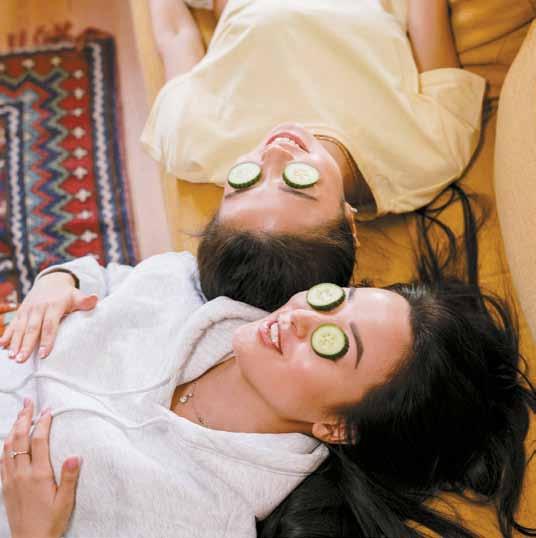
15 minute read
TAI CHI AND QIGONG
Life Force in Motion
by Marlaina Donato
Advertisement
The flowing movement of tai chi mirrors the serenity of water, but still waters run deep. This ancient practice of gentle meditative movement is an offshoot of Chinese martial arts that offers a spectrum of surprising benefits, including healthier soft tissues and bones, as well as improved sleeping.
According to Harvard Health Publishing, when practiced consistently, tai chi supports both upper and lower body strength with effects that are akin to resistance training and brisk walking. Tai chi helps to fine-tune neurons of the inner ear and encourages muscle and ligament flexibility, resulting in better balance and fewer falls. The practice is highly adaptable and anyone can benefit, even those that are wheelchair-bound or recovering from surgery.
“It appears effortless, with slow and smooth movements, but there is immense power underneath the tranquility,” says Paul Lam, family physician and director of the Tai Chi for Health Institute, in Sydney, Australia. “Tai chi has been shown by over 500 medical studies to benefit almost all aspects of health, including mobility, immunity and heart and lung function.” Lam also highlights other related benefits, including lower blood pressure, less arthritis pain and stress relief. 30
Research published last year in the journal Evidence-Based Complementary and Alternative Medicine shows that 12 weeks of tai chi practice initiated beneficial changes in the immune system with subsequent improvement of lung function in children ages 6 to 12 with asthma.

A River of Energy
While tai chi is a modified martial art with a focus on form, its close relative, qigong, is a mind-body wellness system that uses breath, simple movement and stillness. Both cultivate qi, or life force, that is believed to permeate all natural existence. The concept of qi, yet to be understood scientifically, is the basis of Traditional Chinese Medicine and the focus of many studies in China and elsewhere.
“It is believed that qi flows throughout and around the body. If we are healthy, the qi will be moving smoothly and abundantly. If we are not healthy, the qi may be stagnant, excessive or deficient,” says qigong instructor and acupuncturist Jeffrey Chand, in British Columbia, Canada.
Robert Chuckrow, a retired physics professor in Ossining, New York, and the author of Tai Chi Dynamics and The Tai Chi Book, explains, “When muscles are tensed, qi is inhibited. Instead,
when muscles are relaxed and the body is open and moves naturally, qi is enhanced. Such cultivation of qi is the main compo- nent of qigong. Tai chi actually includes qigong.” Chuckrow currently has two students that are 100 years old and notes that seniors greatly appreciate and benefit from these arts once they experience the connection between mind and body.
Lee Holden, a qigong master teacher at the Holden QiGong Center,in Santa Cruz, California, emphasizes the conse- quence of being in perpetual “fight-orflight” mode from everyday, nonthreaten- ing life stresses. “The waves crashing to the shore, the river flowing down the mountain, demonstrate nature’s bound- less energy. We, as human beings, have cut ourselves off from that source of energy. Through qigong practice, we plug back into that natural energy reserve and circulate it through our minds and bodies. Stress, like a kink in the hose, causes a stagnation of qi. Relaxation, like unwind- ing the kink, gets the qi to flow.”
Nourishing the Nervous System
Tai chi and qigong lower the stress hor- mone cortisol, improve brain function and have been shown to decrease symptoms of anxiety and depression. Both approaches are part of many addiction recovery pro- grams to help nourish mind-body connec- tions for better managing stress.
“In my view, both qigong and tai chi are wonderful exercises for the nervous system, which during practice, undergoes intense moment-to-moment receiving, processing and sending of neural electrical information. This electricity stimulates cells to absorb oxygen and nutrients and expel waste products, and it beneficially helps ar- range material within cells,” says Chuckrow.
In essence, it’s all about encouraging calm, something we all need. Chand sum- marizes its benefits superbly. “It empowers individuals to help themselves. The more stress management tools we have to help ourselves, the better our overall health and quality of life is.”
Marlaina Donato is a body-mind-spirit author and visionary composer. Connect at AutumnEmbersMusic.com.




the pandemic intensifying the normal academic, social and hormonal turmoil of these pivotal years. It’s no wonder teens are reporting record levels of stress, anxiety and depression: In a Pew Research survey, 70 percent of teens said mental health was a major problem among their peers—and that was in February, before the pandemic hit. A recent online poll found that most teens are worried that the pandemic will affect their family’s physical or financial health and that many feel lonelier than usual and worry about losing ground in academics and activities.
Extending a helping hand to teens is not always well received. They can be notoriously resistant to advice, even when they’re stressed, partly because of their brain chemistry, explains Gail Saltz, M.D., clinical associate professor of psychiatry at the New York Presbyterian/Weill Cornell School of Medicine and host of the Personology podcast. A teen’s highly active amygdala makes risk-taking a thrill even as the frontal lobe that weighs consequences is not fully developed, while at the same time, a teen seeks independence—an identity and freedom to be more like an adult. “This combination means their capacity and interest in taking parental direction is not there,” she says. “As a result, parents in reaction often get louder and more insistent in telling them what to do, which fails and drives them further away.”
The best way to communicate with a stressed teen, say many child psychologists, is to listen deeply while letting them do most of the talking, and offering sympathetic support while withholding judgment. Instead of giving advice, “Validate your teen’s experience and attempt to step into their shoes. Let your teen know that you hear them, that you support them in their decisions and ask your teen what you can do to help them,” advises clinical psychologist Alyssa Austern, PsyD, of Chatham, New Jersey. Other steps can
cottonbro/Pexels.com
Stressed-Out Teens
Ways to Help Them Chill
by Ronica O’Hara
Being a teenager is never easy, but it’s even harder these days, with the upheaval of
help a teen weather this time of high stress:
1Back up the basics. Make sure there’s healthy food and snacks in the fridge. Encourage teens to exercise daily, especially outdoors, and support them in getting eight to 10 hours of sleep.
2Make self-compassion a family habit. The self-compassion approach to self-care, which is rapidly gaining ground among psychologists, has three elements: treating ourselves as kindly as we would a dear friend, realizing that many other people have the same problems so we’re not alone, and mindfully and nonjudgmentally observing our emotional state.
This method has proven to be helpful not just for adults, but for teens, as well. A University of Edinburgh meta-analysis that synthesized 17 studies of more than 7,000 teens in six countries concluded that those with high levels of self-compassion had lower levels of stress caused by anxiety and depression. University of North Carolina researchers found that teens exhibited lower stress, anxiety and depression, as well as more resilience and gratitude, after six self-compassion sessions.
A good place for parents to start is with themselves: If they are anxious, overprotective or fearful, a teen is likely to follow suit, reports a study in the Journal of Abnormal Child Psychology. Helpful books, websites and programs for both teens and adults can be found at SelfCompassion.org, operated by Dr. Kristin Neff, an associate professor of educational psychology at the University of Texas at Austin who was a pioneer in the concept.
3Engage them with creative activities. As teens can seek independence, making sure they spend quality time with the family is also important for their well-being, research shows. “Find ways to connect, converse and unwind together as a family,” advises Crissy Fishbane, of RaleighDurham, North Carolina, co-founder of HER Health Collective, an online community for mothers. “Teens need to see their parents engaging in self-care behaviors themselves, and it’s even better if you can engage in self-care as a family.” She suggests taking a virtual or outdoor yoga class together, playing a board game, having sudoku competitions, learning deepbreathing techniques or starting a family book club.
4Encourage reaching out to help others. A study in theJournal of Adolescence suggests that altruistic behaviors, including large and small acts of kindness, may increase teens’ feelings of self-worth, especially if it involves helping strangers. In Poland, the more teens helped out others in a flood, the more supportive and proactive they became, another study found. Depending on their interests, teens may be drawn to local environmental, social justice, religious or political activities. DoSomething.org offers useful ideas and links, and environmental projects for teens can be found at EarthForce.com, SierraClub. com and GlobalClimateStrike.com.
Ronica O’Hara is a Denver-based health writer. Connect at OHaraRonica@gmail.com.
Other Helpful Resources Making Friends with Yourself: A Mindful Self-Compassion Program for Teens and Young Adults: centerformsc.org/ msc-teens-adults
Seven Expert Tips for Talking with
Teens:ParentAndTeen.com/keep-teenstalking-learn-to-listen/tal
How to Communicate with Your Teen
Through Active Listening:Psy-Ed.com/ wpblog/communicate-with-teen The Kid’s Guide to Service Projects: Over 500 Service Ideas for Young People Who Want to Make a Difference

If you don’t design your own life plan, chances are you’ll fall into someone else’s plan. And guess what they have planned for you? Not much. ~Jim Rohn

Mark Nepo on Living a Wholehearted Life
by Sandra Yeyati
Bestselling author, poet, cancer survivor and inspirational spiritual teacher Mark Nepo has published 22 books and made numerous appearances on Oprah Winfrey’s Super Soul Sunday program. His latest book, published this year, is The Book of Soul: 52 Paths to Living What Matters.
What do you mean by, “To be broken is not a reason to see all things as broken?”
In my cancer journey, after I had a rib removed from my back and a botched chemo treatment, I found myself in a Holiday Inn getting sick every 20 minutes, frightened and in pain, not sure what to do. As the sun started coming up, I realized that while this was happening to me, it wasn’t happening to everyone. Somewhere nearby, a baby was being born and a couple was making love for the first time. Somewhere an estranged parent and grown adult child were talking for the first time after many years. That’s when it came to me that to be broken is no reason to see all things as broken, because the wholeness of life is what is healing. When I am broken, I need the company of those who know what it’s like to be broken, but I also need everything not broken to heal. When I’m afraid, I need the company of those who know what it’s like to be afraid, but I need everything safe to heal.
How does acceptance strengthen our resilience?
Acceptance is not resignation. Acceptance begins with the hard task or practice of seeing things as they are. When we can see things as they are—clearly—then we have real choices. So, if I am afraid and I give over to my fear, then I’m afraid of everything. If I can see things as they are, I can see more clearly exactly what I’m afraid of, and then I have real choices of what my next steps are. Acceptance lets us move forward.

What practices do you recommend?
Two of the oldest medicines known to human beings are our ability to hold and our ability to listen. Even though there are times when I have been told things I didn’t want to hear, there has never been a time that I have listened or been listened to that hasn’t been healing. There has never been a time when I have held or been held that hasn’t been healing.
Another practice is being completely present and holding nothing back. We tend to drift up into our minds, especially when afraid, and one of the reasons that all of the different traditions have breathing or meditation practices is to return us to where we are. If I start worrying, if I start getting lost in my fear, I try to look at whatever is before me. I’m in my study as I’m talking to you. I’m looking out the window. I’m seeing the leaves on the trees. I take a breath and try to give my full attention to whatever is before me, and then I start getting grounded again.
The thing is, we’re never going to be free of fear or pain, because that’s part of living, but when we can be present and practice being real and authentic, then the fear lives in us and we don’t live in the fear.
What is the power of authentic expression?
One of the most powerful things we can do when feeling powerless is admit the truth. When I was a little boy, I was so captivated by a butterfly that I wanted to look at it closely. I didn’t want to hurt it, so I carefully cupped it in my hands. But then I realized that as long as I had it cupped in my hands, I couldn’t see it. I had to let it go to see its magnificent, colorful wings. Forty years later in my cancer journey, I realized that this [experience] was a teacher about expression. When we keep things closed inside us, they pound and make a lot of noise, but we don’t see them. Once we express them, we’re lighter and we see their true colors.
For more information, book readings and conversations, visit MarkNepo.com. For webinars, visit Live.MarkNepo.com.
Sandra Yeyati, J.D., is a professional writer. Reach her at SandraYeyati@gmail.com.
Do I Need a Nutrition Coach?

by Hayley Imbriani, LMT & Dr. Kevin Granger
What do professional singers, and nutrition are not “one size fits all”. athletes, actors and artists have Some foods that may be healthy for one in common? You might say A person may be harmful to another. As we LOT of practice, and that is very true. But examine the world of food and health, we all of the great ones have a great coach. see that food labels are sneaky and many do The elite in any profession must know ALL not have our best interest in mind. Glutenthe ins-and-outs in their field and must free and/or fat-free do not necessarily mean have developed exceptional skills. They are good for you and may be just the opposite. coached to a level of smooth and polished Terms and words like “natural flavorings” execution. often turn out to be hidden sugars, grains,
All of us could benefit from having a chemicals and additives and these can coach educate, train and guide us into the cause devastating effects on your health. person we want to be. Becoming healthy You want to eat better and you want is no different. There is so much conflictto improve your health, but where do ing information out there when it comes you start? Who do you trust and who has to health and nutrition that it becomes a the true data on safe and natural body priority to get some expert guidance. We regeneration? By now, you have probably are all unique individuals and our bodies begun to realize or at least suspect that big are unique as well. Many health and nugovernment, big farms, big pharma and trition principles can be applied to most big food industries are more interested in people, however, some of us have very profit than they are in your wellbeing. We specialized needs and restrictions. Health are all products of our upbringing, our past habits and routines, and the ideas we have picked up from all of the “opinion leaders” in our life. And we may have grown up in a lifestyle with little emphasis on health. It can be difficult to learn healthy habits all on your own. Even more important is to make sure you are doing it correctly for you and your family as they are relying on you to make important food decisions for them. Who’s in charge at your house to grocery shop?
At Nutritional Wellness, in Clearwater, they coach and educate individually on what not to eat, what your body needs to feel better, and how to grocery shop for yourself, your family and friends. With the guidance of their nutritional professionals, they work oneon-one to help you achieve your health goals, specifically identifying where you need the most help for your specific health conditions, and create a plan with you on how to reach these health goals. They also offer a personalized nutrition coaching program of 12 classes, teaching the basics of how to create a balanced meal; which foods are known dangers for promoting inflammation, heart conditions and cancer; and which foods promote true body regeneration, even finding if there are harmful toxins in your daily products and cosmetics.
Individuals can take one class, two or as many as needed to help educate and guide themselves to better health choices, benefiting everyone in their orbit. Being healthy is a lifestyle, not a fad. To truly learn how to live this lifestyle, it is important to seek correct data and true knowledge. This will assure you are on the correct path. Working with health professionals will help keep you accountable as you travel along in your health journey.
Nutritional Wellness is located at 205 S Myrtle Ave., Clearwater. For more information, call 727-248-0930 and/or visit GrangerHealth.com. See ad page 14.



